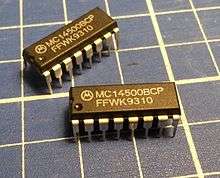1-bit architecture
| Computer architecture bit widths |
|---|
| Bit |
| Application |
| Binary floating-point precision |
| Decimal floating-point precision |

A 1-bit computer architecture is an instruction set architecture for a processor that has datapath widths and data register widths of 1 bit (1/8 octet) wide.
An example of a 1-bit computer built from discrete logic SSI chips[1][2] were the Wang 700 (1968/1970)[3] and Wang 500 (1970/1971)[4] calculator as well as the Wang 1200 (1971/1972)[5] word processor series of Wang Laboratories.
An example of a 1-bit architecture that was actually marketed as a CPU is the Motorola MC14500B Industrial Control Unit (ICU),[6][7] introduced in 1977 and manufactured at least up into the mid 1990s.[7] One of the computers known to be based on this CPU was the WDR 1-bit computer.[8] A typical sequence of instructions from a program for a 1-bit architecture might be:
- load digital input 1 into a 1-bit register;
- OR the value in the 1-bit register with input 2, leaving the result in the register;
- write the value in the 1-bit register to output 1.
This architecture was considered superior for programs making decisions rather than performing arithmetic computations, for ladder logic as well as for serial data processing.[6]
There are also several design studies for 1-bit architectures in academia, and corresponding 1-bit logic can also be found in programming.
Other examples of 1-bit architectures are programmable logic controllers (PLCs), programmed in instruction list (IL).
Several early massively parallel computers used 1-bit architectures for the processors as well. Examples include the Goodyear MPP and the Connection Machine. By using a 1-bit architecture for the individual processors a very large array (e.g.: the Connection Machine had 65,536 processors) could be constructed with the chip technology available at the time. In this case the slow computation of a 1-bit processor was traded off against the large number of processors.
1-bit CPUs can meanwhile be considered obsolete, not many kinds have been produced and none are known to be available in the major computer component stores (as of 2016, a few on eBay[9]). The Finnish company Partco still sells MC14500B as spare part in 2017.[10]
See also
References
- ↑ Wasserman, Katie (March 2006) [January 2004]. "LED calculators rule her house". Computer Collector Newsletter / Technology Rewind (Interview). Interviewed by Koblentz, Evan. Retrieved 2017-05-20.
Probably my most favorite is the Wang 500. It's got several unique things about it: a very unusual ROM memory made of hundreds of long enamel-coated wires wrapped around iron cores; a super-fast single-bit CPU built out of SSI logic chips; and of course tons of really cool-looking colorful keys.
- ↑ Product Service - Schematic manual (PDF). Wang Laboratories, Inc. 1974. 03-0019-0. Archived (PDF) from the original on 2017-05-20. Retrieved 2017-05-20.
- ↑ Müller, H. "Programmierbare Rechner der 3. Generation mit einfacher IC-Technik" (in German). Kelkheim/Taunus, Germany: technikum29. Wang 700 & Wang 500. Archived from the original on 2017-05-20. Retrieved 2017-05-20.
- ↑ "Wang Model 500 programmable calculator". Computer History Museum (CHM). Catalog Number X222.83. Archived from the original on 2017-05-20. Retrieved 2017-05-20.
- ↑ Battle, Jim (2010-03-07). "Wang 1200 - Wang WP History". Archived from the original on 2017-05-21. Retrieved 2017-05-21.
- 1 2 Gregory, Vern; Dellande, Brian; DiSilvestro, Ray; Malarkey, Terry; Smith, Phil; Hadley, Mike (1977). Motorola MC14500B Industrial Control Unit Handbook - Theory and Operation of a CMOS one-bit processor compatible with B series CMOS devices (PDF). Motorola Semiconductor Products Inc. 33-B78/8.0. Retrieved 2017-05-20. (NB. Also available in German language under the title "Motorola MC14500B Industrial Control Unit Handbuch - Theorie und Anwendung eines Ein-Bit-CMOS-Prozessors".)
- 1 2 Industrial Control Unit MC14500B (PDF). Motorola CMOS Logic Data. Semiconductor Technical Data (revision 3 ed.). Motorola. 1995. pp. 306–313. Archived (PDF) from the original on 2017-05-20. Retrieved 2012-08-01.
- ↑ Ludwig, Volker; Paschenda, Klaus; Schepers, Heinz; Terglane, Hermann-Josef; Grannemann, Klaus; John, Burkhard; Komar, Hermann; Meinersen, Ludwig (1986). Written at Neuss & Recklinghausen, Germany. Fast alles über den WDR-1-Bit-Computer (PDF) (in German). Neuss, Germany: DATANorf. Archived (PDF) from the original on 2017-05-20. Retrieved 2017-05-20.
- ↑ http://www.ebay.com/itm/Motorola-IC-MC14500B-MC14500BCL-100-NEW-/320837692605
- ↑ "CMOS-LOGIC IC 4500 DIP16". Archived from the original on 2017-05-20. Retrieved 2017-01-03.
Also known as MC14500BCP
Further reading
- Mueller, Dieter (2012). "The Wang 700 ALU". Archived from the original on 2017-09-08. Retrieved 2018-07-18.
- Mueller, Dieter (2012). "Wang 700 BCD correction". Archived from the original on 2017-09-10. Retrieved 2018-07-18.
- Mueller, Dieter (2005) [2004]. "The famous/infamous MC14500". Archived from the original on 2017-08-03. Retrieved 2018-07-18.
- Mueller, Dieter (2008). "MC14500 and arithmetic". Archived from the original on 2017-05-20. Retrieved 2018-07-18.
- Mueller, Dieter (2008). "A MC14500 modification". Archived from the original on 2017-03-20. Retrieved 2018-07-18.
External links
- Schembri, Thierry; Bizoirre, Sylvain; Boisseau, Olivier; Chauvaud, Pierre-Emmanuel. "WDR-1-Bit Computer". OLD-COMPUTERS.COM. Archived from the original on 2017-05-20. Retrieved 2017-05-20.